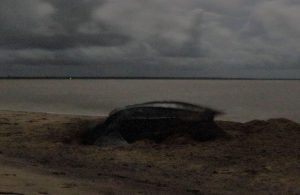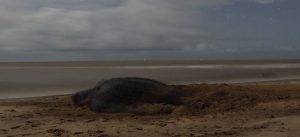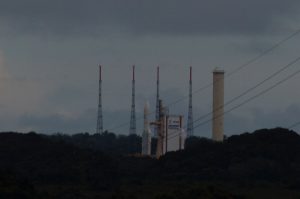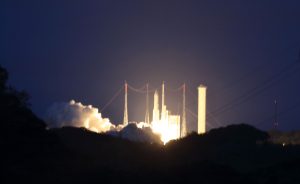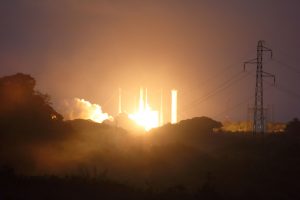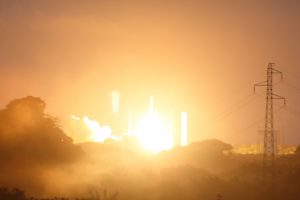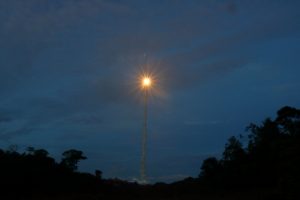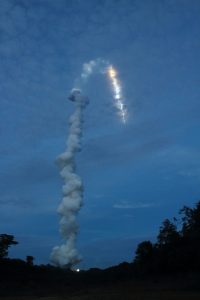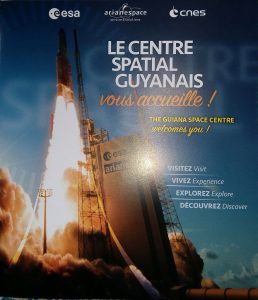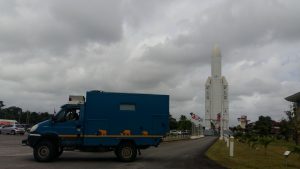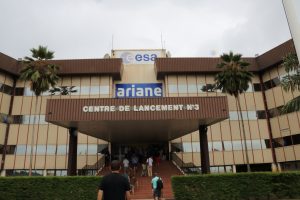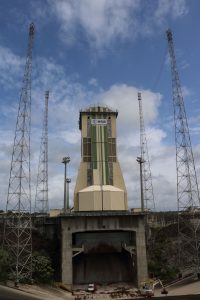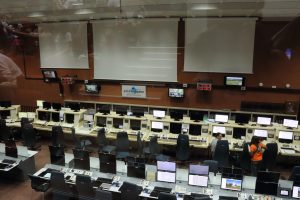There are turtles and there are giant leather-back turtles. And then there are space rockets. An odd combination, but in French Guiana we’re lucky enough see both in the same week. The end of our last blog featured a cliff-hanger, waiting to see whether our application for tickets to the next French Guiana rocket launch will be successful. Well… we got them! And whilst we contain our excitement before the big launch day, we head off to see the giant leather-back turtles on the beaches of the far north corner.

Giant Leather-backs
Over the years we’ve had a few ‘turtle experiences’ on our travels: in Galapagos we swam with them, in Borneo we saw new hatchlings take their first trundle to the sea, and after sleeping on the sand in Oman we woke to find that one had laid her eggs right next to us during the night! These ladies at Les Hattes Beach in French Guiana however, are in a different league… giant leather-backs… the largest in the world.
For our turtle watching here in French Guiana we have a good news/bad news scenario. Good news: it’s nesting season and many giant leather-backs come up the beach every night to deposit their eggs. Bad news: it’s a new moon and we don’t have great visibility. As we wander down to the beach in the dark we worry that we may miss seeing the turtles in the poor light. But when we get there… Wow! Even on a dark, moonless night you’d have to be blind not to spot these beautiful monsters!
The tide is receding leaving a wide, unblemished expanse of sand across which the turtle tracks are easy to spot. Immediately as we step onto the beach we see the unmistakable deep, dark marks of a turtle track. The flipper marks are over two metres across and lead from the ocean, up to the edge of a dune-bank where she lays calmly digging her egg-pit, oblivious to us creeping past her.
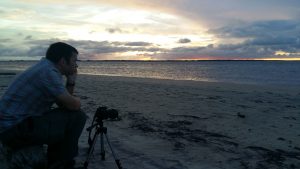
Turtle-watch… they don’t come ’til after dark!
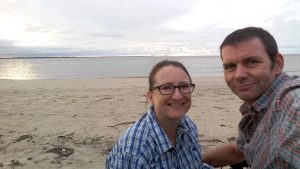 Further along the beach we perch on a washed-up tree trunk and wait. After just a few minutes a huge shadow of a dome emerges from the waves, crawling slowly up the beach towards us. As she comes within two or three metres of us we sit silent and still. We can hear her laborious breathing over the sound of the waves; through the sand we can feel the thud of her huge, powerful flippers propelling her 200kgs of body-mass at a snail’s pace (maybe that should be turtle’s pace ).
Further along the beach we perch on a washed-up tree trunk and wait. After just a few minutes a huge shadow of a dome emerges from the waves, crawling slowly up the beach towards us. As she comes within two or three metres of us we sit silent and still. We can hear her laborious breathing over the sound of the waves; through the sand we can feel the thud of her huge, powerful flippers propelling her 200kgs of body-mass at a snail’s pace (maybe that should be turtle’s pace ).
She is well over 2 metres long, her body is over a metre wide; her sheer size and the curious pattern of her shell gives her a decidedly dinosauric (is that a word? I think I just made that up) appearance. When she finds her spot, she uses all four flippers to dig a huge pit into which she sinks as she displaces the sand from underneath herself. The little rear flippers do their thing, but the volume of sand displaced by one of the huge main flippers would cover a dog in a single swipe. The final pit must be around a metre deep and after depositing her eggs into the depths, she replaces the sand on top.
Nesting over, the tracks back to the ocean and the huge mound of disturbed sand above the nest are conclusive evidence of where the hatchlings should emerge in a few weeks’ time. I say should… this beach is by far the least protected and most threatened turtle nesting site that we have seen in the world. There is no attempt to protect the nests and the public (even un-supervised dogs) wander freely over the whole area. A walk along the beach in daylight reveals many signs of nest raiding and we reckon that the chances of these little chaps ever making it to swim freely in the oceans themselves must be pretty low.
To avoid flash photography around the turtles, we have only a couple of rubbishy grainy pictures taken from several metres away on a very long exposure and then edited to enhance the brightness. Disappointing, but instead of photos we take away special memories from here.
French Guiana Rocket Launch
We are kids of the original Space Race, growing-up in the Apollo era, captivated by the fuzzy black and white TV images of moon-landings. Space stuff has come a long way since then but for us, has lost none of its fascination. The Centre Spacial Guyanaise (CSG) launches three types of rockets: Ariane 5, Soyuz and Vega. Ariane 5 is by far the biggest and most powerful of the three, so we really want to see one of these if possible.
After a long wait due to the political palaver here… we’re in luck! An Ariane 5 launch is announced for May 4th (Star Wars Day!). We apply for tickets and wait. Meanwhile, we visit the museum and join one of the daily CSG tours where the public are shown around the facility. It’s all very interesting, but no substitute for seeing the real thing!!
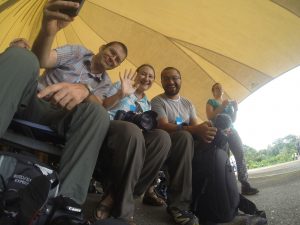
Waiting for the launch
Finally, we have places at the Agami view-site – a great vantage point. Boarding the coach-transfer, our first briefing is how to use our gas-masks if there is any emergency during the launch! Errr… I thought we had tickets for a view-point, not to drive the rocket !! It seems that at only 7km from the launch-pad, we will be in range of some nasty fall-out if it all goes horribly wrong!
The Agami site has huge screens set-up at the side so we can see what is going on in the control room. We receive mission updates and explanations of the phases: launch, jettison, mission monitoring, satellite deployment etc, etc, etc.
- Arianne
Ten minutes to go and we’re nervous: cloud-base is low and likely to hamper views of the trajectory. The clouds are clearing but not fast enough for our liking . The 7 minute count-down starts, then very quickly stops. At 6 minutes, 59 seconds… ooops… a ‘Code Red’! Could be a tea-break for the control room, but probably a bit more serious. Our hearts sink at the prospect of the launch not going ahead, but 20 minutes later… the launch is back on and the clouds have cleared!
At 17:50 hrs local time, we witness the spectacular sight of Ariane 5 Mission Number VA236 taking to the sky: a countdown, a deep rumble, a detonation of engines, an extraordinarily brilliant flash of deep orange light, an expanding plume of billowing smoke, a jettison blast, and finally the distant crackle of the engines and the light-trail disappears deep into the darkening evening sky (see short video clip below). The smoke-plume takes a long time to dissipate and our attention turns to the giant screens to follow the mission.
Less than one hour after lift-off, two satellites are deployed. We see scenes of congratulatory back-slapping around the control room. Cynically… we now have two new pieces of future space-junk in orbit around our planet, but more positively… there is a newly expanded telecommunication capability for the people of Brazil and of South East Asia . For us, it was a chance of a lifetime to see the space race in action, but maybe we’ll come back if they launch to Mars!
Click here for details on how to attend a launch
Farewell French Guiana
So at last we’ve made it from border to border and sit in the pretty river town of St. Laurent. In the morning, we’re heading across the Maroni River to Suriname. Due to the recent political shenanigans, our stay here has lasted a bit longer than we had planned. Nevertheless, as ‘places-to-get-stuck’ go, French Guiana isn’t bad! It’s the EU, but in the tropics! We’ve had a bit of a struggle speaking Francaise, but the wildlife, the rocket launches, the coffee and the scrummy croissants all make up for that .
Link to next blog: Suriname – time-out Link to full South America Blog
Monster Turtles and Rockets – French Guiana Picture Gallery
- Waiting for the launch
- Turtle-watch… they don’t come ’til after dark!
- Arianne

